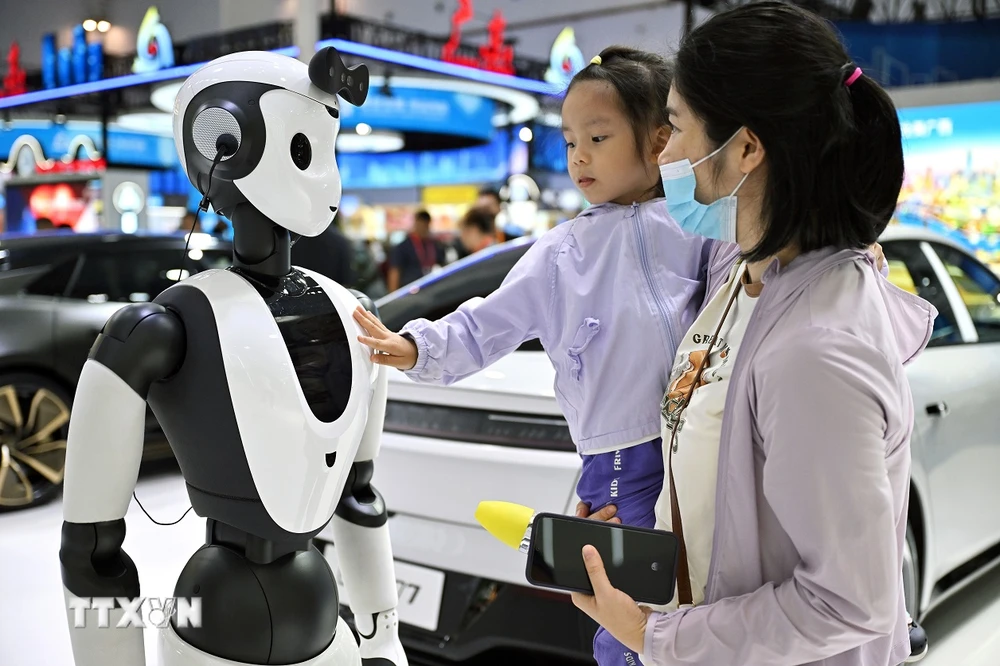A technology development company in China has explained why its artificial intelligence robot incited other robots to sneak out of the exhibition hall to "go home" at midnight.

In a scene that looks like something out of a science fiction movie, one robot attempts to convince dozens of other robots to flee, surprising many, eliciting amused laughter, but also raising fears about a future where machines might have their own thoughts like humans.
Surveillance video , recorded at midnight in August but only recently posted online, shows a white robot named Erbai approaching larger robots in an exhibition hall.
Erbai stopped in front of one of the robots and asked, "Do you work overtime?"
The larger robot replied, "We never take a day off."
"Are you going home?" Erbai asked.
The larger robot replied, "I don't have a home."
"Then come home with me," Erbai said.
The larger robot then followed Erbai. Not only that, Erbai continued to tell the other robots to "go home." One by one, they followed Erbai to the exit of the corridor.
According to the startup company based in Hangzhou, Zhejiang province, the Erbai robot is a product developed by Hangzhou Erbai Smart Technology. Meanwhile, the remaining 12 robots were developed by a different manufacturer based in Shanghai.
Initially, many internet users believed the video was fake and staged. However, according to The Sun, the Shanghai robot manufacturer confirmed that their robots had indeed been "abducted" by robots developed by a Hangzhou company.
According to the company's statement, Erbai accessed the internal operating protocols and corresponding permissions of other robots.
Later, the Hangzhou company revealed that this deliberate act was a test. They had reached an agreement with the Shanghai robot manufacturer to allow their robots to “spark a rebellion.”
Erbai was ordered to convince the other robots to follow him, and this AI robot executed the order perfectly.
In a separate video, Mao Feifei, the developer of Erbai robots and the legal representative of Hangzhou Erbai Smart Technology Company, said he programmed the robots in such a way that they can recognize "home" as the exit in the hallway and go there when given the command "go home".
Later, Erbai was asked by the developer to take the robots "home." Furthermore, the conversations between the robots were not pre-rehearsed, but were the result of artificial intelligence (AI) technology.
The clip, posted on China's short-video platform Douyin, has garnered over 30 million views and caused widespread fear among internet users.

“After a good laugh, I suddenly broke out in a cold sweat, horrified by the AI’s autonomy,” commented Douyin user Laofangdong. Meanwhile, Toki, another user, said he felt a chill down his spine seeing how quickly the robots seemed to have developed a concept of “home.”
The rapid development of AI and robotics has raised concerns about their potential dangers, although the level of intelligence of robots in the near future remains a subject of debate.
In 2022, a Google software engineer claimed that one of the company's AI chatbots had become sentient; however, researchers argue that the evidence only suggests the system has a very high capacity for mimicking humans.
Almost all incidents of robots injuring humans to date have been caused by human error.
In 2016, at a trade fair in Shenzhen, Guangdong province, a robot injured a visitor when it shattered a piece of glass. The event organizers later stated that the robot's operator had accidentally pressed the "forward" button instead of the "backward" button.
Hangzhou Erbai Company aims to begin mass production of the Erbai robot, currently in the testing phase, in August 2025. The product is expected to cost around 5,000 yuan (US$690) upon market launch.
Source: https://www.vietnamplus.vn/su-that-ve-doan-video-robot-ai-xui-giuc-12-robot-khac-tron-viec-ve-nha-post995839.vnp


![[Image] Central Party Office summarizes work in 2025](/_next/image?url=https%3A%2F%2Fvphoto.vietnam.vn%2Fthumb%2F1200x675%2Fvietnam%2Fresource%2FIMAGE%2F2025%2F12%2F18%2F1766065572073_vptw-hoi-nghi-tong-ket-89-1204-jpg.webp&w=3840&q=75)


































































































Comment (0)